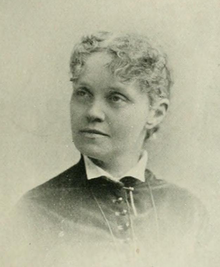Harriet Maxwell Converse
| Harriet Maxwell Converse | |
|---|---|
 |
|
| Born | Harriet Arnot Maxwell January 11, 1836 Elmira, New York |
| Died | November 18, 1903 (aged 67) |
| Nationality | American |
| Genre | folklore, poetry |
| Notable works | Sheaves |
Harriet Maxwell Converse (née, Harriet Arnot Maxwell; Seneca clan name, Gayaneshaoh; Seneca tribal name, Ya-ih-wah-non or Gaiiwanoh; 11 January 1836 - 18 November 1903) was an American author of Scottish and Irish heritage. She was a folklorist, poet and historian of the Iroquois; by the late 19th century, they were a loose confederacy of six nations in New York State and Canada. She became an advocate for the rights of the Seneca and other Iroquois tribes in New York state, helping them retain their lands and preserve their culture. In recognition of her contributions, the Seneca made her a member of the tribe and gave her an honorary position as a sachem or chief of the Six Nations.
With an appropriation in 1897 from the New York State Museum, Converse made extensive purchases of Iroquois artifacts from private collectors and tribes to have them preserved by the state. She also donated a family collection that was a century old. She persuaded the Onondaga to transfer their collection of historic wampum belts of the Five Nations to the state museum for preservation.
Harriet Arnot Maxwell was born in Elmira, New York, in 1836, daughter of Thomas Maxwell and Maria (Purdy) Maxwell. Her father had a concern for Native Americans in New York State and was active in politics; he was elected and served in office at the county, state and federal level, being elected as a Congressman. He later became vice-president of the Erie Railroad. Her mother was a woman of culture and education. Her paternal grandfather, Guy Maxwell, had been an Indian trader in Virginia and New York, moving to Elmira in the late 18th century after the United States achieved independence. Both men had been adopted by the Seneca to honor them. Her mother Maria died when Harriet was nine, and her father sent the girl to live with relatives in Milan, Ohio. There she attended public school.
Converse entered a larger public life after her second marriage. After she and her husband traveled, in the late 1860s they happened to meet Ely S. Parker in New York City. He was a Seneca who had become an engineer and served with General Ulysses S. Grant in the American Civil War. He was highly influential in the Seneca Nation and in New York politics.
...
Wikipedia
